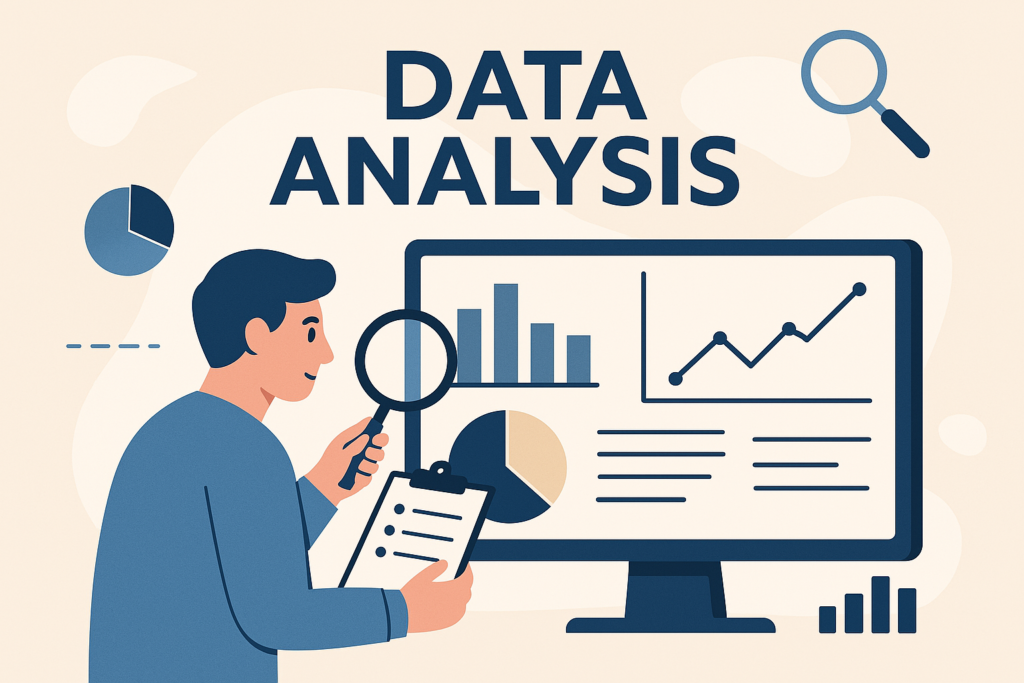In today’s digital era, data is often referred to as the „new oil.“ With the exponential growth in the amount of data generated every day—from social media interactions and online transactions to sensor readings and customer feedback—organizations are increasingly relying on data analysis to make sense of it all. But what exactly is data analysis, and why is it so important?
What is Data Analysis?
Data analysis is the process of systematically examining, transforming, and modeling data to discover useful information, draw conclusions, and support decision-making. It involves collecting raw data, cleaning it to ensure accuracy, analyzing it using statistical and computational techniques, and interpreting the results to gain actionable insights.
There are different types of data analysis, including:
- Descriptive Analysis: Summarizes historical data to identify patterns and trends. For example, analyzing last quarter’s sales figures.
- Diagnostic Analysis: Examines data to understand the reasons behind certain outcomes. For instance, exploring why sales dropped in a particular region.
- Predictive Analysis: Uses statistical models and machine learning to forecast future events. A common example is predicting customer churn.
- Prescriptive Analysis: Suggests actions to achieve desired outcomes, often using optimization and simulation techniques.
Each type of analysis plays a unique role in helping organizations make informed decisions.
Why is Data Analysis Important?
- Better Decision-Making
At its core, data analysis empowers organizations to make decisions based on evidence rather than intuition. Whether it’s choosing the right marketing strategy or managing supply chains efficiently, data-driven decisions tend to be more accurate and effective. - Improved Efficiency
Through analysis, businesses can identify bottlenecks, redundancies, or areas of waste. For example, by analyzing logistics data, a company might discover that certain delivery routes are less efficient and adjust them accordingly, saving both time and money. - Understanding Customer Behavior
In today’s competitive market, understanding the customer is key. Data analysis helps companies track buying habits, preferences, and engagement levels. This knowledge can be used to personalize offerings, improve customer service, and increase loyalty. - Risk Management
Data analysis allows organizations to assess risks by identifying warning signs and predicting potential issues before they occur. For instance, banks use data to detect fraudulent transactions in real-time. - Innovation and Competitive Advantage
Companies that leverage data effectively are often the ones leading their industries. By uncovering unmet needs or market trends through data analysis, businesses can innovate and stay ahead of the competition. - Scientific and Academic Research
Outside of the business world, data analysis plays a crucial role in fields like healthcare, environmental science, and social research. It allows researchers to test hypotheses, validate theories, and contribute to knowledge in a reliable way.
Tools and Technologies
Modern data analysis is supported by a wide range of tools and technologies. These include:
- Spreadsheets (like Microsoft Excel or Google Sheets) for basic analysis.
- Statistical Software (such as R and SAS) for more advanced techniques.
- Business Intelligence Tools (like Tableau, Power BI) for visualizing data.
- Programming Languages (such as Python and SQL) for manipulating large datasets.
- Machine Learning Platforms (like TensorFlow or scikit-learn) for predictive analysis.
Choosing the right tools depends on the complexity of the data, the goals of the analysis, and the skills of the analyst.
Challenges in Data Analysis
Despite its benefits, data analysis is not without challenges. Data quality is a common issue—if data is incomplete, outdated, or inaccurate, the conclusions drawn may be flawed. Additionally, data privacy and ethical concerns must be addressed, especially when dealing with sensitive personal information.
Another hurdle is the shortage of skilled professionals who can analyze data effectively. As demand for data literacy grows, there’s an increasing need for training and education in this field.
The Future of Data Analysis
As technology continues to evolve, data analysis is becoming more powerful and accessible. Artificial intelligence and machine learning are automating many aspects of the process, enabling real-time insights and more sophisticated forecasting. Meanwhile, the rise of big data—datasets that are too large or complex for traditional methods—is opening new frontiers in fields like genomics, climate science, and urban planning.
In the future, data analysis will likely be embedded in everyday decision-making across all sectors. It will no longer be just the domain of data scientists but a critical skill for managers, marketers, educators, and policymakers alike.
Conclusion
Data analysis is more than just crunching numbers—it’s about turning raw data into meaningful insights that drive success. In a world overwhelmed by information, the ability to analyze data effectively is a vital competitive edge. Whether you’re running a business, conducting research, or simply trying to understand the world better, data analysis is an indispensable tool in the modern age.


